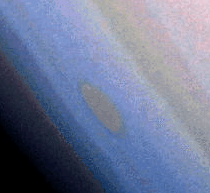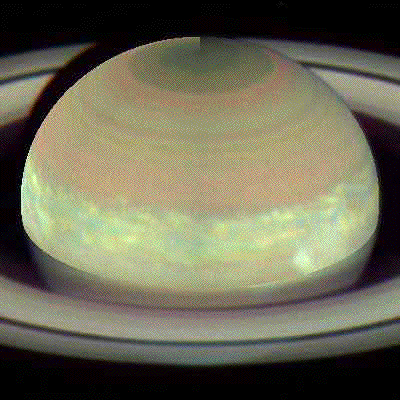The Surface and
Interior
 The surface of Saturn bears many similarities with the surface of Jupiter, but
the color contrast is generally less. This is thought to be due to Saturn being
colder than Jupiter (further from the Sun), so it has different chemical
reactions in its atmosphere, leading to different coloration.
The surface of Saturn bears many similarities with the surface of Jupiter, but
the color contrast is generally less. This is thought to be due to Saturn being
colder than Jupiter (further from the Sun), so it has different chemical
reactions in its atmosphere, leading to different coloration.
There are large anticyclonic cells on the surface, apparently driven by the
planet's internal heat source, but none are as large as the Great Red Spot on
Jupiter, and they are not as abundant as on Jupiter. The image adjacent left
shows a red anticyclonic disturbance about the diameter of the Earth.

Storms on Saturn
The adjacent animation shows a sequence of Hubble Space Telescope
images of the Great White Spot,
a disturbance discovered in 1990 that can extend completely around the
planet. The same storm is illustrated with greater smoothness in this
Hubble Space Telescope
movie sequence
(Ref).
High-Velocity Winds
There are extremely high velocity winds in the atmosphere of Saturn. Unlike
the case for Jupiter, the variations in wind speeds are not strongly correlated
with the positions of the belts and bands. The wind speeds in the atmosphere
of Saturn have been measured to be as high as 1800 km/hr, which is about 4
times the highest speeds in the atmosphere of Jupiter.
The Interior of Saturn
Like Jupiter, Saturn is largely liquid. The slightly lower concentration of
helium relative to hydrogen in the atmosphere of Saturn compared to Jupiter
is thought to be be due to the
colder temperature of Saturn. Under these colder conditions, liquid helium
does not dissolve in liquid hydrogen and drops of helium sink to the center,
depleting the outer regions in helium. Speculation on Saturn's internal heat
source is similar to that for Jupiter.
The magnetic field of Saturn is similar
to that of Jupiter, but weaker. Electrical currents in liquid metallic
hydrogen deep in the interior are assumed to be the cause of the magnetic
field. The magnetic field traps charged particles
in "Van Allen belts" similar to that of the Earth.
(Jupiter also traps particles but the belts are more extended
in radius and thus are more like annular sheets. Saturn
has less extensive of a trapped charged particle region than
Jupiter.)
 The surface of Saturn bears many similarities with the surface of Jupiter, but
the color contrast is generally less. This is thought to be due to Saturn being
colder than Jupiter (further from the Sun), so it has different chemical
reactions in its atmosphere, leading to different coloration.
The surface of Saturn bears many similarities with the surface of Jupiter, but
the color contrast is generally less. This is thought to be due to Saturn being
colder than Jupiter (further from the Sun), so it has different chemical
reactions in its atmosphere, leading to different coloration.
